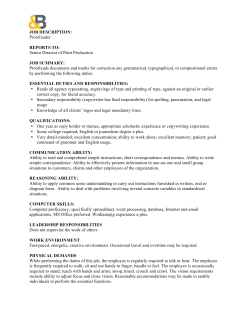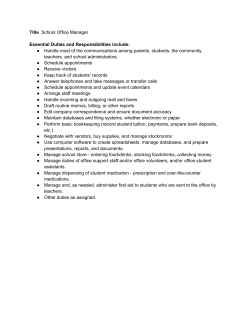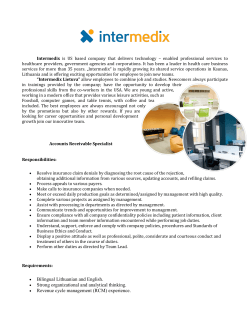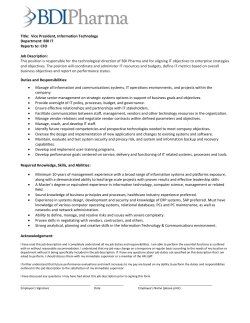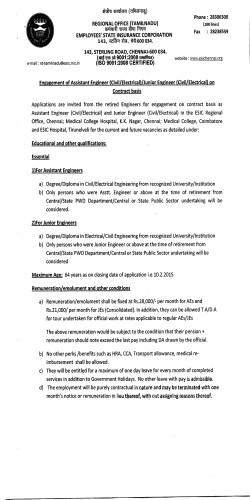
Excess Employees - Income Maintenance
DETERMINATION 2: EXCESS EMPLOYEES - INCOME MAINTENANCE publicsector.sa.gov.au DETERMINATION 2 OF THE COMMISSIONER FOR PUBLIC SECTOR EMPLOYMENT EXCESS EMPLOYEES – INCOME MAINTENANCE Public Sector Act 2009 Determination 2: Excess Employees – Income Maintenance Date of Operation 1 January 2011 Date of update June 2015 Review Date Not earlier than 1 March 2016 Who is covered by this Determination? Under section 16(1) of the Public Sector Act 2009 (“PS Act”) the Commissioner for Public Sector Employment: “…may issue determinations relating to (a) employment in the Public Service; and (b) public sector employment outside the Public Service that is declared by another Act or the regulations under this Act to be employment to which this section applies.” This Determination applies to: • Employees in the Public Service employed in a public sector agency that is an administrative unit or attached office, as defined by the PS Act; and also • Public sector employees whose employment has been declared by another Act or the regulations under the PS Act to be employment to which the above Section 16(1) of the PS Act applies. This determination is made pursuant to section 16(1) of the PS Act and regulation 18(b) of the Public Sector Regulations 2010. If you are in any doubt as to whether this Determination applies to your employment, please contact your Human Resource Management unit. Determination 2 of the Commissioner for Public Sector Employment Excess Employees – Income Maintenance Page 2 of 5 CONTENTS Who is covered by this Determination? ...............................................................................................................................................................2 1. DEFINITION OF AN EXCESS EMPLOYEE ...............................................................................................................................................4 2. INCOME MAINTENANCE FOR EXCESS EMPLOYEES..................................................................................................................... 4 3. ADDITIONAL INFORMATION..........................................................................................................................................................................4 Determination 2 of the Commissioner for Public Sector Employment Excess Employees – Income Maintenance Page 3 of 5 1. DEFINITION OF AN EXCESS EMPLOYEE An employee is excess to requirements when they are not employed in a substantive, funded role, duties or positon and it is not practicable to transfer the employee to another suitable substantive, funded role, duties or position commensurate with their substantive remuneration level. 2. INCOME MAINTENANCE FOR EXCESS EMPLOYEES 2.1 The Commissioner for Public Sector Employment determines that where an employee is transferred to a role, duties or position at a lower remuneration / classification level pursuant to section 53(1)(a) of the PS Act – on the basis the employee is excess to of the agency at the higher (substantive) remuneration level, the employee will continue to be remunerated at the rate they were being paid at the time they were transferred for the following periods: • for an employee with at least one year continuous service but less than ten years – for a period of six months; or • for an employee with at least ten years continuous service – for a period of twelve months. 2.2 An income maintenance period will begin three (3) months following the employee being transferred to a role, duties or position at the lower remuneration / classification level. Chief executives, agency heads or delegates may extend the period of income maintenance in exceptional circumstances. 2.3 A period of income maintenance need not be continuous. Should an excess employee be temporarily transferred into a suitable role, duties or position at their substantive classification level (or a higher level) during the time that income maintenance is applicable such income maintenance will be suspended for the relevant period. Income maintenance will recommence at the completion of the temporary transfer, if the employee resumes the role, duties or position at the lower remuneration / classification level. 2.4 An employee will be entitled to a second or subsequent period of income maintenance, if, after having been transferred to an ongoing substantive, funded role, duties or position, they again become excess to requirements and are transferred to another role, duties or position with a lower classification / remuneration level. 2.5 The rate payable to an employee during a period of income maintenance is the rate applicable to the substantive remuneration level they were employed at prior to being declared excess and includes increases awarded through enterprise bargaining. Remuneration includes any allowances prescribed through awards, enterprises agreements or other industrial instruments. It does not include attraction or retention allowances unless the terms of the allowance require payment to the employee regardless of the duties they perform. 2.6 Where, at the cessation of a period of income maintenance, an employee is not performing duties at the relevant substantive remuneration level - the employee’s remuneration will be pegged at that amount until such time as the remuneration applicable to the classification of any new role, duties or position they occupy equals or exceeds the pegged rate of pay. 2.7 An employee whose rate of pay is pegged shall not receive any increase to remuneration, whether incremental or otherwise (e.g. general salary increase applicable under an Enterprise Agreement) until such time as the remuneration for any new role, duties or positon they occupy equals or exceeds the pegged rate of pay. 3. ADDITIONAL INFORMATION A period of income maintenance does not commence until an employee is transferred to a role, duties or position at a lower remuneration / classification level. In other words, a period of income maintenance does not necessarily commence at the time an employee becomes/is declared excess to requirements – unless this coincides with transfer to a role, duties or position at a lower remuneration / classification level. A chief executive, agency head or delegate must be satisfied that it is not possible to transfer an employee to other duties at their substantive remuneration level, before they transfer or assign the employee to a role, duties or position at a lower remuneration level. Pursuant to section 53 of the PS Act, a public sector agency may not reduce an employee’s remuneration level unless the agency has made reasonable endeavours to find, but has failed to find, other suitable duties in the agency, or other public sector employment, to which the employee might be assigned or transferred on conditions that maintain the Determination 2 of the Commissioner for Public Sector Employment Excess Employees – Income Maintenance Page 4 of 5 employee’s substantive remuneration level. Pursuant to section 62 of the PS Act, any decision to reduce an employee’s remuneration level, or to transfer or assign an employee to a different place, that reasonably requires the employee to change his or her place of residence is a prescribed employment decision and therefore potentially subject to review by the Industrial Relations Commission of South Australia. Determination 2 of the Commissioner for Public Sector Employment Excess Employees – Income Maintenance Page 5 of 5
© Copyright 2026

